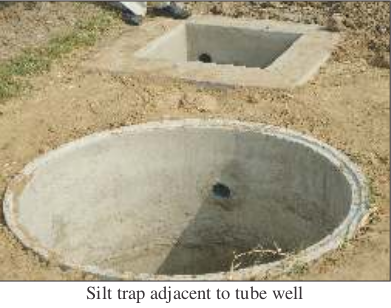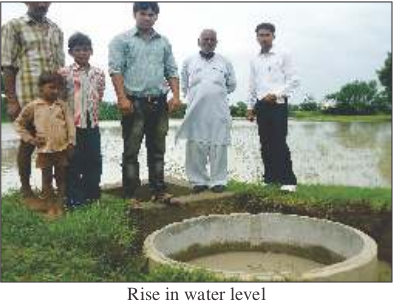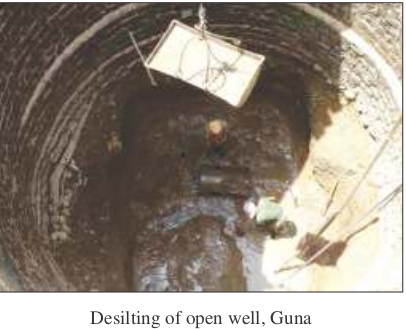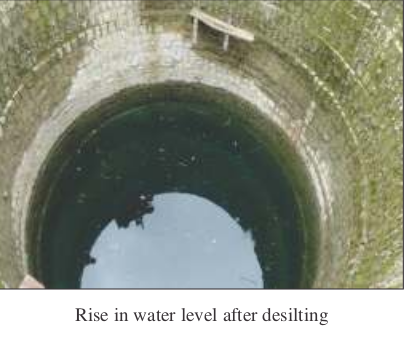Recharge of wells to improve shallow aquifers
Recharge of wells to improve shallow aquifers
Climate vulnerability
Low and erratic rainfall
Existing practice
During last 10 years in Sitara village, Bharatpur, farmers suffer from water shortages for crop production due to declining water table. Rabi crops often suffered due to moisture stress affecting productivity. As farmers were not aware of in-situ soil and moisture conservation techniques, 35-40% of total rainfall was being lost as runoff.
Resilient practice / technology
To address this problem, recharging of tube wells was taken up as a major intervention. The technique involved diverting runoff to a pit dug around the tube well after trapping the silt. About 8 to 10 cement rings were descended into the dugout around the tube well. Harvested rainwater is collected in a cement tank and allowed for the silt to settle down and then conveyed to the dugout using a PVC pipe. Material required for recharging included cement rings (8-10 numbers, 4.5 ft radius, 2 ft height), bricks (500), cement (1 bag), pipe (10 ft long) and one perforated pipe (6ft long). Average cost incurred was Rs.10,000 out of which 25 per cent of total cost and labor was shared by the farmer.
Impact
During 2012-13, 54 bore wells were recharged in the village. This intervention led to significant increase in the shallow aquifer levels (2.5 to 4 m). Despite prevalence of high temperature (36 to 40°C) in the pre-rabi period of 2012-13, farmers could give pre-sowing irrigation before taking up the rabi crops such as mustard, barley and wheat. This helped them to take up timely sowing and harvest a good yield. In the absence of such a facility, farmers would normally wait for temperature to come down resulting in delayed planting. Delayed planting of rabi crops often leads to coinciding of critical crop growth stage with warmer temperatures affecting seed setting and yield reduction.
During 2013-14, about 60 tube wells were recharged (95% were successful) and water table rose by 8 to 10 ft. This water was made available for irrigation in 242 ha land out of 365 ha in the village. Major crops sown in the rabi season viz. wheat, mustard and barley benefitted due to availability of recharged groundwater.


In Chamaluru village of Anantapur district (Andhra Pradesh) new farm ponds were constructed in farmers’ fields to recharge bore wells. The size of the farm ponds was 22 × 22 × 1.5 m each having water storage capacity of 726 m3.
The farm pond of Eshwar Reddy got filled twice with runoff water with the receipt of 174 mm of rainfall in September 2013. Five bore wells located in the premises of farm pond were recharged. One defunct bore well started functioning and irrigated area increased by 2 ha.
Another farmer (Ravi ) recharged 2 bore wells located around his farm pond. The depth of the water table on 11th September in functioning well was 7.75 m as against 28.5 m on 11th April 2014.
Another farm pond was dug in Sri Gopal Reddy's field with a storage capacity of 750 m3. About 5-6 bore wells located in the vicinity of farm pond were recharged. The depth of water table in bore wells increased by 9 feet.
Monitoring of water table in wells adjacent to farm pond
| Well no | Name ofthe Farmer | Distancefrom farm pond(m) | Water table depth (m) | |||||||
|---|---|---|---|---|---|---|---|---|---|---|
| Sep 13 | Oct 13 | Nov 13 | Dec 13 | Jan 14 | Feb 14 | Mar 14 | Apr 14 | |||
| 1 | Eshwar Reddy | 64 m | 9.4 | 9.8 | 13.0 | 14.9 | 17.1 | 11.75 | 12.50 | 12.50 |
| 2 | Y.Ravi | 128m | 11.1 | 10.5 | 13.5 | 12.6 | 17.4 | 12.12 | 13.25 | 13.50 |
| 3 | S.Adi Narayan | 75m | 9.4 | 10.8 | 12.2 | 12.4 | 17.8 | 12.37 | 11.75 | 13.0 |
| 4 | Gopal Reddy | 228 m | 11.4 | 11.3 | 16.5 | 15.0 | 16.6 | 14.25 | 16.25 | 14.50 |
| 5 | Venkateswar | 270 m | 9.6 | 11.9 | 16.0 | 16.1 | 18.9 | 15.25 | 16.25 | 13.0 |
| Average | 10.2 | 10.9 | 14.1 | 14.2 | 17.6 | 13.1 | 14 | 13.3 | ||
| Rainfall details | ||
|---|---|---|
| Month | Rainfall mm | Rainy days |
| Sep 13 | 174 | 6 |
| Oct 13 | 24 | 3 |
| Nov 13 | 0 | 0 |
| Dec 13 | 0 | 0 |
| Jan 14 | 0 | 0 |
| Feb 14 | 0 | 0 |
| Mar 14 | 28 | 2 |
| Apr 14 | 13 | 1 |
Similarly, desilting of open wells is another intervention taken up in many villages. Open wells (14 wells) in Sarkho village, Guna, Madhya Pradesh were used as irrigation sources in the distant past. They have now become defunct due to silting up.
At Sarkho village, Guna, farmers took up de-silting works of three open wells during 2011-12 and three open wells during 2012-13 in summer to benefit 23 farmers. Irrigation efficiency doubled while irrigated area increased by 50% due to de-silting.
- Depth of open wells increased by 21.3% through de-silting in two consecutive years.
- Productivity of Wheat, Gram and Coriander increased by 26, 28 and 29%, respectively due to recharge of open wells through de-silting.
- Average cropping intensity across farmers increased by 17%.


Scope for upscaling
Scarce rainfall areas in Rajasthan, Andhra Pradesh, Maharashtra, Gujarat and Karnataka.
Source: Smart practices and Technologies for Climate Resilient Agriculture
Last Modified : 2/12/2020
This topic provides information about Captive rear...
This topic provides information about Check dams f...
This topic provides information about Crop diversi...
This topic provides information about Community ta...
